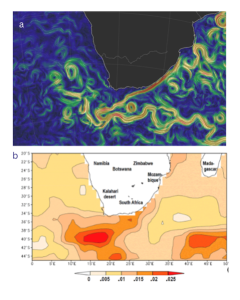The Atlantic Meridional Overturning Circulation (AMOC) is a critical regulator of global climate. It is part of the global thermohaline circulation whose primary climate role is to transfer heat and salt from the sub-tropics to the high latitude regions (red track in figure below), from where most of the heat is lost to space and the strong cold water related CO2 sink is transferred and stored in the deep ocean (blue track in figure below). Together, they moderate and stabilize climate to make the planet habitable.
Without the AMOC transport of cool, dense, CO2 -rich waters into the deep ocean, fossil fuel CO2 emissions would raise atmospheric CO2 levels much faster and cause a higher rate of global warming and climate change, thus a greater risk to human society.

Schematic of the AMOC, with warm water flowing north, sinking in northern latitudes and then returning as a cold deep current to the south. The background map shows the sea surface temperature change since 1870 based on ocean observations, including the AMOC slowdown fingerprint of a ‘cold blob’ in the subpolar North Atlantic and excessive warming north of the Gulf Stream. Figure adapted from Caesar et al. (2018).
From measured paleo-climate indicators, it is known that the AMOC is very sensitive to changes in the salinity of the north Atlantic as well as the temperature gradient between the sub-tropics and the high latitude oceans. any modern period weakening in the AMOC is of great scientific and societal concern.
A recent article, released on 28 August 2025, suggests that this critical regulating system is at risk of shutting down by 2100.
The researchers based this claim on the results from the so-called “Coupled Model Intercomparison Project (CMIP) Phase 6” and its CMIP6 model simulator. As the name of the project suggests, this is the sixth phase of a scientific collaboration, coordinated by the Intergovernmental Panel on Climate Change (IPCC) – Working Group 1 (WG1). This collaboration brings climate modeling groups together from around the world to compare outputs from standardized climate model simulations run by each group.
The models developed by each group incorporate and couple atmosphere, ocean, land surface and ice components to simulate the impact of different emission scenarios on global and regional climate (also known as Shared Socioeconomic Pathways or SSPs).
The startling take home message from this latest in a long line of similar efforts is this: “Of particular concern is our finding that deep convection in many models stops in the next decade or two, and that this is a tipping point which pushes the northern AMOC into a terminal decline from which it will take centuries to recover, if at all.”
What would happen if the AMOC were to shut down?
“A shutdown of the AMOC would result in a warming of the Southern Hemisphere oceans and atmosphere especially around the Southern African ocean system, which is a bottleneck for the heat transfer from the tropical Indo-pacific oceans and the Atlantic Ocean,” said Professor Pedro Monteiro, Oceanographer at the SU School for Climate Studies (SCS), “it would have a significant impact on regional climate through changes in the characteristics of variability of the water cycle and heat extremes, the emergence of ecological tipping points and accelerated sea level rise from collapse of Antarctic ice shelves.”

a: The Agulhas current bottleneck for the transfer of heat around the tip of Africa from the tropics of the Indo-Pacific oceans to the AMOC in the form of eddies and b: the SST warming trend oCy-1 1900-2016 (Images from earth.nullschool.net and Jury, 2021 doi.org/10.5194/os-16-1529-2020).
“You’ll get an accumulation of warmer waters around the southern Cape, which would accelerate regional warming,” says Professor Guy Midgley, Director of the SU School for Climate Studies (SCS), “because the shutdown would reduce transfer of warm Agulhas Current waters into the Atlantic.”
In relation to biodiversity, an AMOC shutdown threatens the climatic stability that underpins biome persistence in the Western Cape, which in turn would negatively impact the region’s rich endemic biodiversity by increasing extinction risk and reducing biome-associated species richness.
Similar events have occurred in recent geological time, and their impacts simulated to understand potential effects on the Western Cape, offering a kind of “pre-warning”. In the past, however, such events have occurred in a cooler world, prior to the higher CO2 world of today. In contrast to the southern Hemisphere, the Northern Hemisphere would experience rapid cooling; early indications of such as shift may already be observable in phenomena like “the cold blob,” a local region around Greenland that is getting colder.
The most recent evidence of an AMOC shut-down is the Younger Dryas period, which occurred about 12,000 years ago. This caused a sudden reversal of the end-Pleistocene warming event that began about 18,000 years ago. This event was triggered when a large ice dam on the North American continent collapsed, flooding freshwater into the North Atlantic near southern Greenland. This is thought to have disrupted the AMOC within a matter of weeks, sharply decreasing temperatures across Europe in particular, clearly visible through the expansion of the cold-adapted plant species Dryas octopetala. Under current climatic and ocean conditions it is considered very unlikely that a shut-down would happen so suddenly; instead, any future collapse is expected to occur much more gradually- unlike the disaster depicted in the science fiction film The Day After Tomorrow.
 Mountain Avens, Dryas octopetala. (Image from https://www.biolib.cz/en/image/id58975/)
Mountain Avens, Dryas octopetala. (Image from https://www.biolib.cz/en/image/id58975/)
What is the previous assessment of AMOC shut-down risk according to the IPCC?
The IPCC Sixth Assessment Report (IPCC AR6) states the following:
- The AMOC is projected to very likely decline over the 21st century under all SSP scenarios, reflecting high confidence in this qualitative feature based on sound process understanding.
- However, there is only medium confidence that this decline will not involve an abrupt or complete collapse before the year 2100. An abrupt collapse remains unlikely but cannot be ruled out with high confidence.
- For the 20th century, the confidence in reconstructed and modelled AMOC changes is low due to discrepancies and low agreement between models and observations, missing key processes in current models and proxy measurements, and new evaluations of AMOC variability.
- This low confidence in historical reconstruction translates into low confidence in the quantitative projections of the AMOC decline in the 21st century, despite confidence in the qualitative likelihood of its weakening.
- The implications of an AMOC collapse, although unlikely before 2100, would be severe, causing abrupt shifts in regional weather patterns, impacts on ecosystems, and human activities.
Recommendations for the IPCC
The most recent IPCC assessment thus concludes on the balance of evidence that AMOC weakening is very likely, but finds that precise quantification of the timing and the likelihood of abrupt collapse remains uncertain due to limitations in data and models. IPCC findings are approved in a consensus process that involves assessment scientists and policy representatives from all IPCC member countries, and remain as the standing assessment until either a special report is published that updates the consensus, or until the next full IPCC assessment.
The Drijfhout et al. paper is an important contribution that signals a potential shift in the balance of evidence behind this IPCC consensus, including the following main points:
- While the IPCC AR6 expressed medium confidence that an abrupt AMOC collapse before 2100 is very unlikely, the Drijfhout et al. paper presents evidence showing that many models undergo a shutdown or near-shutdown of the northern AMOC after 2100, especially under the high-emission (SSP585) scenario. This extended projection indicates the AMOC may collapse more slowly over the 22nd and 23rd centuries rather than abruptly within the 21st century. The paper argues this slow “shutdown” over 50-100 years is distinct from abrupt collapse events seen only in models that introduce a large, localised input of freshwater.
- The study finds that a northern AMOC shutdown is predicted by multiple models not only in the high emission scenarios but also in some cases under intermediate (SSP245) and low emission (SSP126) scenarios, indicating a higher risk than previously thought.
- The paper highlights a tipping point mechanism involving the collapse of deep convection (or deep mixing) in the Labrador, Irminger, and Nordic Seas as a major precursor to AMOC shutdown, a process already showing decline in observations over the last 5-10 years. This mechanistic understanding adds confidence to the projection of AMOC weakening and eventual shutdown.
- The authors emphasize salt-advection feedback and the role of salinity changes in destabilizing AMOC, triggered by global warming-induced surface warming and freshening, over ocean surface heat flux changes.
- The shutdown leads to a sharp reduction in northward heat transport and ocean heat release to the atmosphere north of 45N, causing regional cooling in the North Atlantic and Europe unless greenhouse warming offsets this.
- The paper notes ongoing model biases in simulating AMOC variability, freshwater forcing from Greenland ice melt, and ocean eddy effects, which introduce uncertainty but overall suggest the risk of shutdown is greater than previously assessed in the IPCC AR6.
- The authors argue that the scenario of a northern AMOC shutdown should no longer be considered a low-likelihood, high-impact event as framed in the AR6, implying a needed revision for the upcoming AR7.
The newly published research suggests that the standing IPCC assessment may be over-conservative, and apart from raising serious concerns about the findings themselves, highlights the limitations of the lengthy IPCC assessment process. How might we better incorporate important new results into standing IPCC assessments in a way that could inform policymakers and other stakeholders credibly of a potential revision of the approved consensus due to shifts in the balance of evidence?
We argue that a more explicit and transparent accounting of the balance of evidence could help, by permitting new findings to be added to the existing body in a way that could provisionally update the standing consensus, pending a formal revision at the following assessment cycle. Establishing such a process and ensuring effective screening and curation of important updates would have at least four significant advantages:
- Policy makers and other stakeholders would be better informed of the evolving evidence base and the need to adjust their perception of risks;
- The process of scoping the following IPCC assessment would be far better informed by a curated process of identifying critical areas for re-assessment;
- The task of the following IPCC assessment itself could be streamlined, especially by allowing the author teams to develop much more content-rich “Zero Order” and “First Order” draft reports, which can be somewhat incomplete; and finally,
- Authors and funders of scientific works could become more engaged in targeting research that could contribute to evidence that might reduce assessed uncertainties most effectively.
The projected AMOC shut-down example may be an object lesson in the need for annual assessments around the top challenges in the Climate – Adaptation – Mitigation space- this could help refine the purpose of the AR cycles of the IPCC and strengthen their own impact. Given the bottleneck nature of the Agulhas system in the AMOC, the question is why SA climate science is not a global leader in this global challenge at our doorstep.
For more information, contact Prof Midgley at gfmidgley@sun.ac.za and Prof Monteiro at pmsmonteiro@sun.ac.za
Feature photo: A visualization of the AMOC, the beginning of the conveyor belt of ocean circulation in the North Atlantic. (Image from https://svs.gsfc.nasa.gov/12629)




